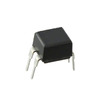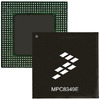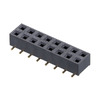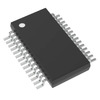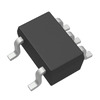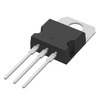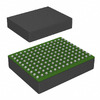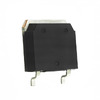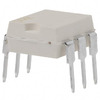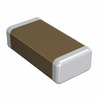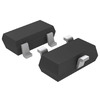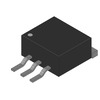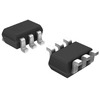AA vs AAA Batteries: Which Is Better for Your Needs?
Catalog
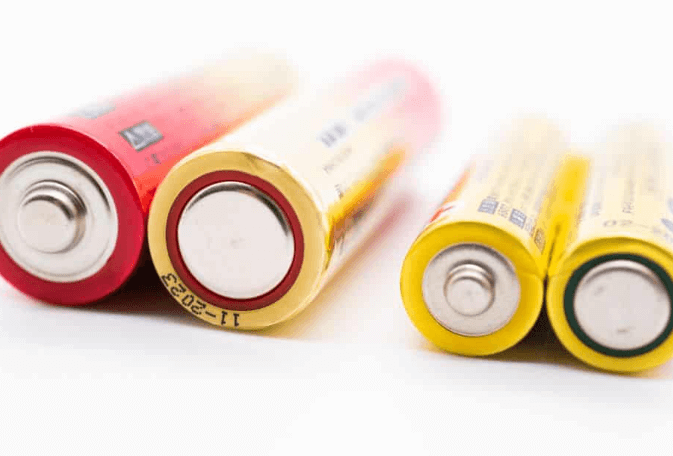
What is an AA Battery?

|
Type |
Chemistry |
Voltage |
Capacity (mAh) |
Rechargeable |
|
Alkaline |
Zinc-manganese dioxide |
1.5 |
1450to 3300 |
No |
|
Lithium |
Lithium-iron disulfide |
1.5 |
110 to 3000 |
No |
|
NiMH |
Nickel metal hydride |
1.2 |
1500 to 3000 |
Yes |
|
Li-ion |
Lithium-ion |
3.6 to 3.7 |
1000 to 3300 |
Yes |
|
Alkaline |
Zinc-manganese dioxide |
1.5 |
1450to 3300 |
No |
Chart 1:Types of AA Batteries
|
Alkaline AA Battery Nominal Voltage |
1.50 Volts |
|
AA Battery Capacity (Avg.)- Alkaline |
≈ 2500 mAh |
|
Operating Temperature |
0°C – 60°C |
|
Diameter |
14.5mm |
|
Height |
50.5mm |
|
Chemistry |
Alkaline |
Chart 2:Technical Specifications of Alkaline AA Battery
|
Lithium AA Battery Nominal Voltage |
1.50 Volts |
|
AA Battery Capacity (Avg.)- Alkaline |
≈3000mAh mAh |
|
Operating Temperature |
0°C – 60°C |
|
Diameter |
14.5mm |
|
Height |
50.5mm |
|
Chemistry |
Lithium |
Chart 3:Technical Specifications of Lithium AA Battery
|
Carbon Zinc AA Battery Nominal Voltage |
1.50 Volts |
|
AA Battery Capacity (Avg.)- Alkaline |
≈400-1,700mAh |
|
Operating Temperature |
0°C – 60°C |
|
Diameter |
14.5mm |
|
Height |
50.5mm |
|
Chemistry |
Carbon Zinc |
Chart 4:Technical Specifications of Carbon Zinc AA Battery
What is AAA battery?
|
Type |
Chemistry |
Voltage |
Capacity |
Rechargeable |
|
Alkaline |
Zinc-carbon |
1.5 V |
1000 to 2700 mAh |
No |
|
NiMH |
Nickel-metal hydride |
1.2 V |
1500 to 3000 mAh |
Yes |
|
Li-ion |
Lithium-ion |
3.7 V |
700 to 2000 mAh |
Yes |
|
LiFePO4 |
Lithium iron phosphate |
3.2 V |
1000 to 2000 mAh |
Yes |
Chart 5:Types of AAA Batteries
Comparison of Battery Size Between AA and AAA Batteries
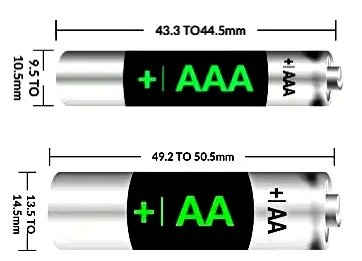
|
Feature |
AA |
AAA |
|
Size |
14.5 x 50.5 mm |
10.5 x 44.5 mm |
|
Volume |
8.3 cm³ |
3.8 cm³ |
|
Weight |
23 g |
13 g |
|
Voltage |
1.5 V |
1.5 V |
|
Capacity |
1400 to 3500 mAh |
600 to 1200 mAh |
|
Current |
1.5 to 2 A |
0.5 to 1 A |
Chart 6: Comparison of AA Battery and AAA Battery Specifications
Comparison of Battery Performance Between AA and AAA Batteries

Comparison of Chemical Composition of AA and AAA Batteries
|
Chemistry |
Common Name |
Rechargeable |
Typical Capacity (mAh) |
Voltage (V) |
|
Zinc Carbon |
R6, 15D |
No |
600 - 1600 |
1.5 |
|
Alkaline |
LR6, 15A |
No (Mostly No) |
1800 - 2700 |
1.5 |
|
Li-FeS2 |
FR6, 15LF |
No |
2700 - 3300 |
1.5 (1.8 max) |
|
Li-ion |
14500 |
Yes |
600 - 2000+ |
3.6 - 3.7 |
|
LiFePO4 |
IFR14500 |
Yes |
500-750 |
3.2 |
|
Li-SOCl2 |
(14505) |
No |
2400-2700 |
3.5-3.6 |
|
Li-MnO2 |
CR AA |
No |
~2000 |
3.0 |
|
Lithium |
- |
Yes |
1000-2000+ |
1.5 |
|
NiCd |
KR6, 1.2K2 |
Yes |
600 - 1200 |
1.2 |
|
NiMH |
HR6, 1.2H2 |
Yes |
700 - 2800 |
1.2 |
|
NiOOH |
- |
No |
2200 - 2700 |
1.5 (1.7 max) |
|
NiZn |
ZR6 |
Yes |
1500 - 1800 |
1.6 - 1.65 |
Chart 7: AA Batteries Chemistries Comparison Table
|
Chemistry |
Common Name |
Rechargeable |
Typical Capacity (mAh) |
Voltage (V) |
|
Zinc Carbon |
R03, 24D |
No |
500-600 |
1.5 |
|
Alkaline |
LR03, 24A |
Mostly No |
850-1200 |
1.5 |
|
Li-FeS2 |
FR03, 24LF |
No |
1100-1300 |
1.5 (1.8 max) |
|
Li-ion |
10440 |
Yes |
350-600 |
3.6 - 3.7 |
|
LiFePO4 |
IFR10440, IFR10450 |
Yes |
250-300 |
3.2 |
|
Li-SOCl2 |
(10450) |
No |
600-800 |
3.6-3.7 |
|
Lithium |
- |
Yes |
400-600 |
1.5 |
|
NiCd |
KR03, 24K |
Yes |
300-500 |
1.2 |
|
NiMH |
HR03, 24H |
Yes |
600-1300 |
1.2 |
|
NiOOH |
ZR03 |
No |
1000-1200 |
1.5 (1.7 max) |
|
NiZn |
- |
Yes |
500-700 |
1.6 - 1.65 |
|
Zinc Carbon |
R03, 24D |
No |
500-600 |
1.5 |
Chart 8: AAA Batteries Chemistries Comparison Table

Comparison of Application Scenarios of AA and AAA Batteries
|
Feature |
Primary Battery |
Secondary Battery |
|
Can be recharged |
No |
Yes |
|
Lifespan |
One use |
Different uses |
|
Cost |
Less expensive |
More expensive |
|
Power output |
Low |
Higher |
|
Self-discharge rate |
High |
Low |
|
Environmental impact |
High |
Low |
|
Applications |
Used in devices that need less power |
it is used in devices that use high-power |
Chart 9: Primary Battery vs Secondary Battery
Cost Comparison of AA and AAA Batteries
|
Battery Type |
Alkaline Price |
Rechargeable Price |
|
AA |
$0.60 to $1.00 per battery |
$1.00 to $2.00 per battery |
|
AAA |
$0.50 to $0.80 per battery |
$1.00 to $1.50 per battery |
Chart 10: Cost Comparison of AA and AAA Batteries

Are AA and AAA batteries interchangeable?
Conclusion
Frequently Asked Questions [FAQ]
1. What are the disadvantages of AA batteries?
2. Which is better, AA batteries or AAA batteries?
3. How many years do AAA batteries last?
4. Why are batteries called AA and AAA?
5. How many hours can AA batteries last?
About us
ALLELCO LIMITED
Read more
Quick inquiry
Please send an inquiry, we will respond immediately.

How Much Do You Know About Lawnmower Batteries?
on April 19th
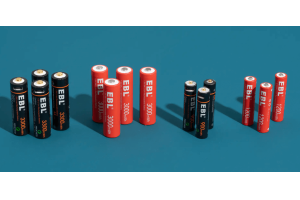
AAA Batteries: Types, Voltage Characteristics, Maintenance
on April 17th
Popular Posts
-

What is GND in the circuit?
on January 1th 3256
-

RJ-45 Connector Guide: RJ-45 Connector Color Codes, Wiring Schemes, R-J45 Applications, RJ-45 Datasheets
on January 1th 2805
-

Understanding Power Supply Voltages in Electronics VCC, VDD, VEE, VSS, and GND
on November 20th 2618
-

Fiber Connector Types: SC Vs LC And LC Vs MTP
on January 1th 2253
-

Comparison Between DB9 and RS232
on January 1th 1868
-

What Is An LR44 Battery?
Electricity, that ubiquitous force, quietly permeates every aspect of our daily lives, from trivial gadgets to life-threatening medical equipment, it plays a silent role. However, truly grasping this energy, especially how to store and efficiently output it, is no easy task. It is against this background that this article will focus on a type of coin cell battery that may seem insignificant on the...on January 1th 1836
-

Understanding the Fundamentals:Inductance Resistance, andCapacitance
In the intricate dance of electrical engineering, a trio of fundamental elements takes center stage: inductance, resistance, and capacitance. Each bears unique traits that dictate the dynamic rhythms of electronic circuits. Here, we embark on a journey to decipher the complexities of these components, to uncover their distinct roles and practical uses within the vast electrical orchestra. Inductan...on January 1th 1791
-

What Is RF and Why Do We Use It?
Radio Frequency (RF) technology is a key part of modern wireless communication, enabling data transmission over long distances without physical connections. This article delves into the basics of RF, explaining how electromagnetic radiation (EMR) makes RF communication possible. We will explore the principles of EMR, the creation and control of RF signals, and their wide-ranging uses. The article ...on January 1th 1781
-

CR2430 Battery Comprehensive Guide: Specifications, Applications and Comparison to CR2032 Batteries
What is CR2430 battery ?Benefits of CR2430 BatteriesNormCR2430 Battery ApplicationsCR2430 EquivalentCR2430 VS CR2032Battery CR2430 SizeWhat to look for when buying the CR2430 and equivalentsData Sheet PDFFrequently Asked Questions Batteries are the heart of small electronic devices. Among the many types available, coin cells play a crucial role, commonly found in calculators, remote controls, and ...on January 1th 1781
-

Comprehensive guide to hFE in transistors
Transistors are crucial components in modern electronic devices, enabling signal amplification and control. This article delves into the knowledge surrounding hFE, including how to select a transistor's hFE value, how to find hFE, and the gain of different types of transistors. Through our exploration of hFE, we gain a deeper understanding of how transistors work and their role in electronic circu...on November 20th 1767
